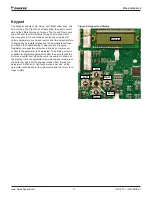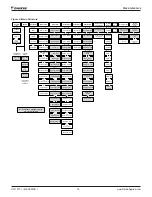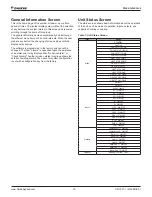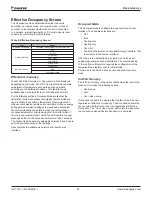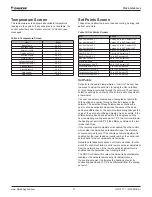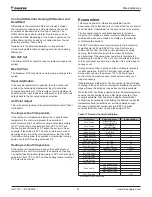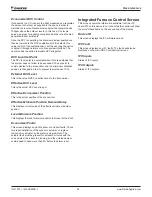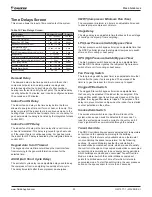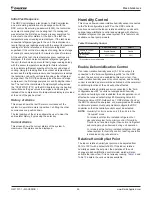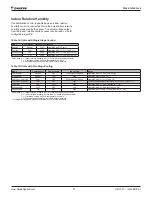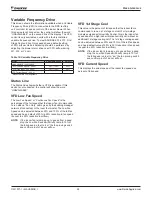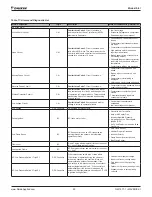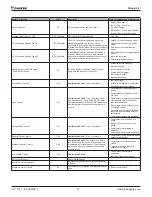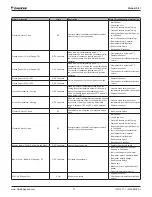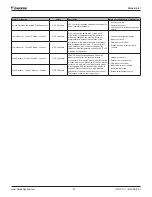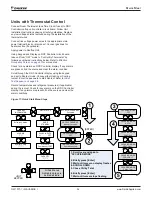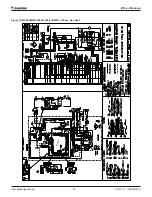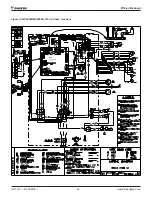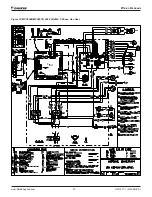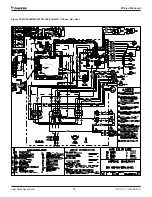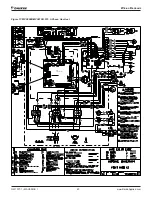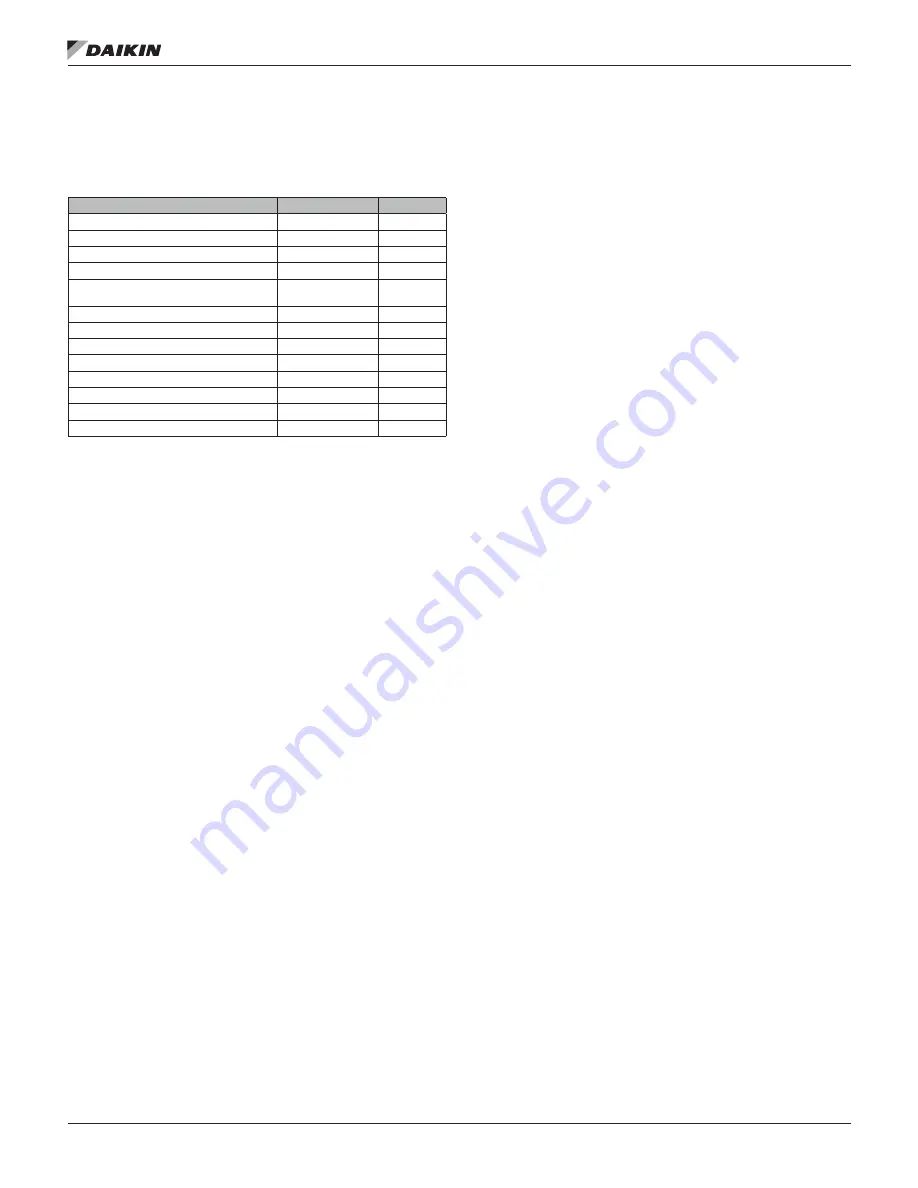
u
ser
I
nTerfaCe
www.DaikinApplied.com 25
OM 1077-1 • MAVERICK I
Time Delays Screen
This screen allows the input of time constants of the system.
Table 12: Time Delays Screen
Time Settings
Adjustable Range
Default
Demand Delay
30 – 1800 sec
300 sec
Indoor Fan ON Delay
1 sec – 180 sec
10 sec
Indoor Fan OFF Delay
1 sec – 180 sec
45 sec
Keypad Auto Scroll Timeout
30 sec – 10 min
5 min
Compressors ASCD
(Anti Short Cycle Delay)
10 sec – 30 min
3 min
CMRT (Compressor Minimum Run Time)
1 – 20 min
2 min
Stage Delay
5 – 300 sec
5 sec
LPS (Low Pressure Switch) Bypass Timer
10 – 90 sec
30 sec
HPS (High Pressure Switch) Bypass Timer
1 – 5 sec
2 sec
Fan Proving Switch
1 sec – 180 sec
20 sec
Clogged Filter Switch
1 sec – 180 sec
20 sec
Smoke Alarm Switch
1 sec – 180 sec
20 sec
Tenant Override
2h – 6h
2h
Demand Delay
The demand delay is the time period in which the control
compares set point to zone temperature readings and
determines whether the current stage of either cooling or
heating is sufficient to satisfy the set point. The demand delay
is set by default at 5 minutes, and it can be configured between
30 seconds and 30 minutes.
Indoor Fan ON Delay
The indoor fan on delay is the time delay before the fan is
allowed to energize after a call for cool, heat, or fan only. This
delay is ignored if the indoor fan is in continuous mode. In the
heating mode, for electric heat models, there is not a delay; for
gas heat models the delay is handled by the integrated furnace
control (IFC).
Indoor Fan OFF Delay
The indoor fan off delay is the time delay after a call for cool
or heat is terminated. This delay is ignored for gas heat units
or if the indoor fan is in continuous mode. For gas heat units,
the indoor fan OFF delay is handled by the integrated furnace
control (IFC).
Keypad Auto Scroll Timeout
The keypad auto scroll timeout will keep the User Interface
from returning to the general information screen for the
selected time.
ASCD (Anti Short Cycle Delay)
The anti short cycle delay is an adjustable delay used to keep
the compressor from re-energizing too quickly after a cycle.
The delay time starts after the compressor de-energizes.
CMRT (Compressor Minimum Run Time)
The compressor minimum run time is an adjustable time used
to ensure proper compressor oil return.
Stage Delay
The stage delay is an adjustable time that keeps the next stage
of cooling or heat pump from energizing.
LPS (Low Pressure Switch) Bypass Timer
The low pressure switch bypass timer is an adjustable time that
the DDC Controller ignores the refrigerant low pressure switch
after a call for cooling or heat pump.
HPS (High Pressure Switch) Bypass Timer
The high pressure switch bypass timer is an adjustable time
that the DDC Controller ignores the refrigerant high pressure
switch after a call for cooling or heat pump.
Fan Proving Switch
The fan proving switch bypass timer is an adjustable time that
starts after the indoor fan is energized. The purpose of the
timer is to give the indoor fan time to come up to speed.
Clogged Filter Switch
The clogged filter switch bypass timer is an adjustable time
that can only be activated if the indoor fan is energized. If the
clogged filter switch input is continuously closed until the time
expires, the clogged filter alarm is tripped. The purpose of the
delay is to prevent nuisance trips when the indoor fan is started
or other pulsations in the airflow.
Smoke Alarm Switch
The smoke alarm switch is an input that will lock out the
system when an open switch is detected for 2 seconds. To
reset the system power must be cycled to the unit or an “all
clear” signal must be communicated through the network.
Tenant Override
The DDC Controller allows separate adjustment of temperature
set points and fan operation according to the building
occupancy. This feature is only available when a thermostat
is not controlling the space temperature. For the following
sections, Occupied Mode implies that the calculation for
demand utilizes occupied set points, which are used to satisfy
the comfort in the space. Unoccupied mode utilizes unoccupied
set points and is normally set to save energy during periods in
which buildings are closed and unoccupied. Tenant Override
Mode is a state in which the control utilizes occupied set
points for a limited amount of time, after which it returns to
unoccupied mode. To start Tenant Override, the user presses a
button on the space sensor for more than 2 seconds.







